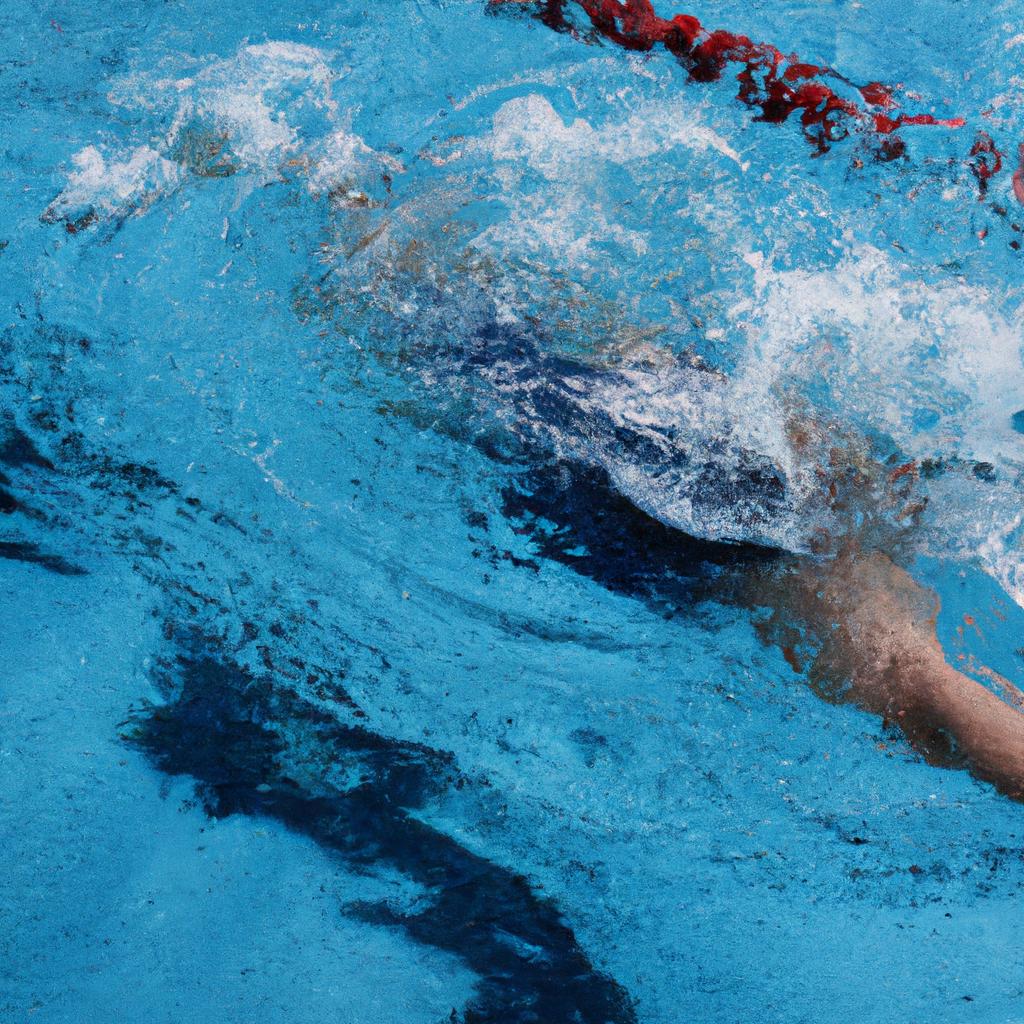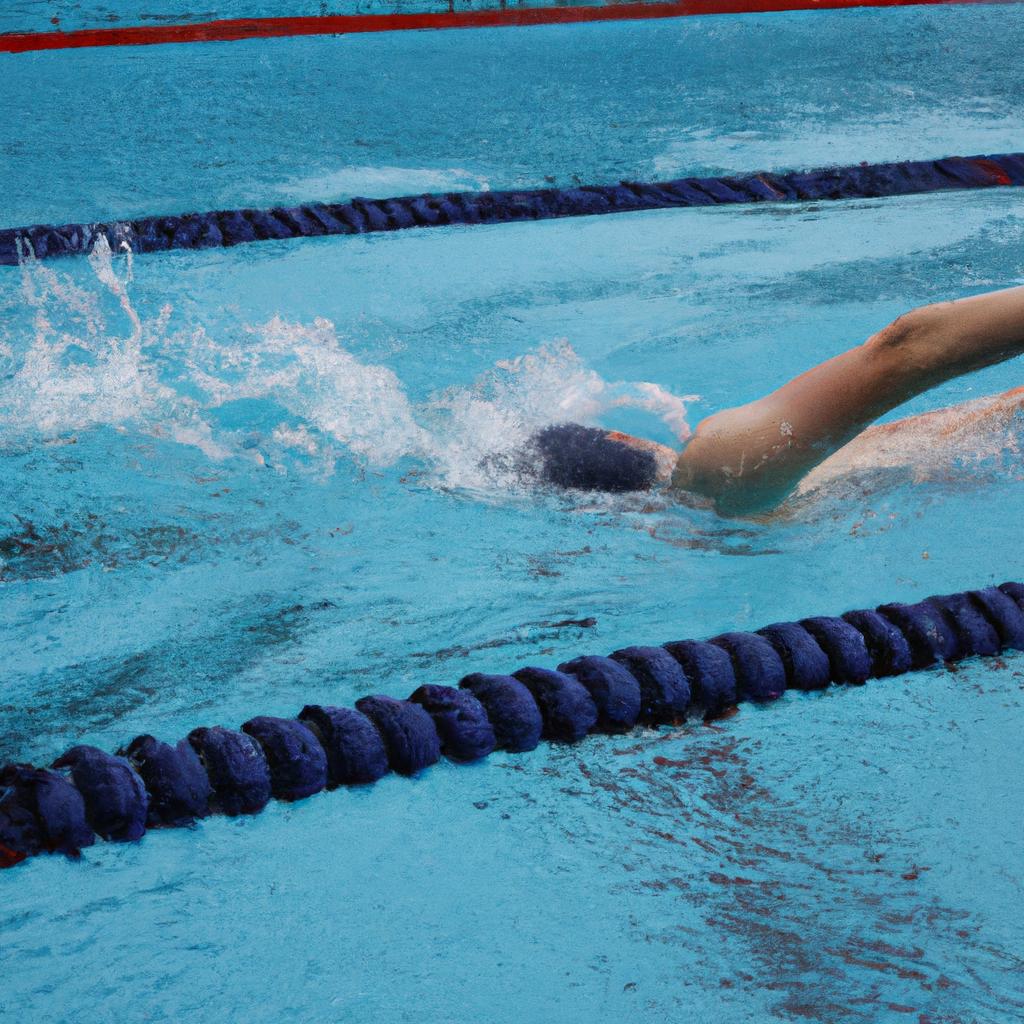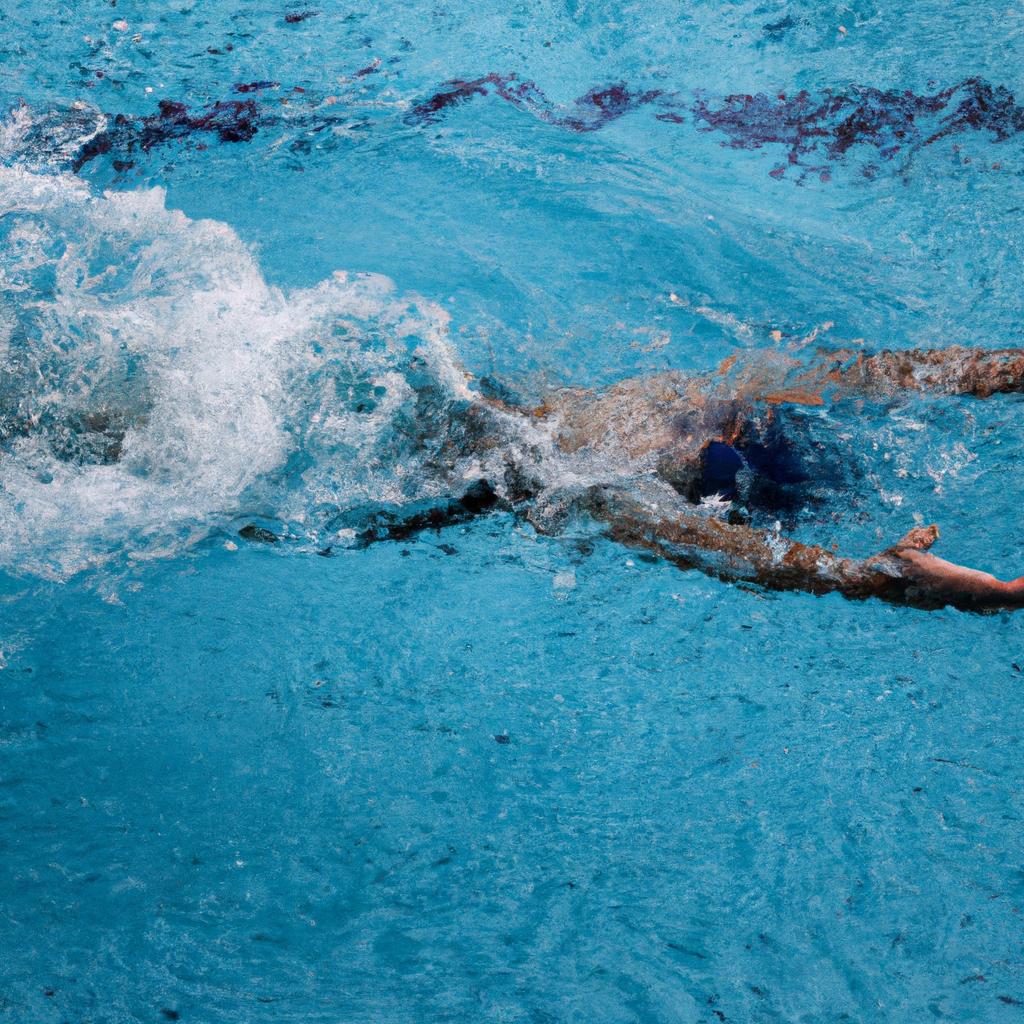The selection and training of coaches play a crucial role in enhancing the performance of athletes at sports clubs. A case study from the Swim & Tennis Club provides an illustrative example of how effective coach selection and training can lead to improved outcomes. This article aims to examine the importance of these processes in optimizing athlete performance, focusing specifically on swimming and tennis.
In recent years, the Swim & Tennis Club faced challenges in maintaining high levels of athletic achievement due to inconsistencies in coach quality. The club decided to revamp its approach by implementing a rigorous process for selecting and training coaches. By adopting this method, they aimed to improve overall athlete performance while also ensuring that each coach possessed the necessary skills and knowledge to effectively train their respective teams.
This article will discuss various strategies employed by the Swim & Tennis Club during coach selection and training. It will explore how careful assessment of applicants’ qualifications, experience, and coaching philosophies has helped identify individuals who align with the club’s vision for excellence. Additionally, it will delve into the specific training programs implemented by the club to enhance coaches’ technical expertise and leadership abilities. Through examining this case study, readers will gain insights into best practices for coach selection and training that can be applied across different sport disciplines within sports clubs.
Benefits of Effective Coach Selection and Training
Effective coach selection and training play a crucial role in enhancing performance at the Swim & Tennis Club. By carefully selecting coaches who possess the necessary skills, knowledge, and experience, as well as providing them with comprehensive training opportunities, clubs can ensure that their athletes receive quality instruction and guidance. This section will explore the benefits of effective coach selection and training, highlighting its impact on both individual athletes and the overall success of the club.
Engaging Example:
Consider a hypothetical scenario where a tennis club hires an experienced coach for their junior program without thoroughly assessing their qualifications or conducting proper interviews. Despite having years of coaching experience, this individual lacks specific expertise in working with young athletes. As a result, they struggle to effectively communicate with the juniors and fail to tailor their coaching methods accordingly. The lack of appropriate coach selection not only hampers the growth and development of these young players but also reflects poorly on the reputation of the club.
Benefits:
- Enhanced Performance: When clubs prioritize effective coach selection and training, they are more likely to attract qualified individuals who can provide expert instruction tailored to each athlete’s needs. Such coaches have a deep understanding of different techniques, strategies, and sports psychology principles required for optimal performance. Consequently, athletes under their guidance experience improved skill development, increased motivation levels, and enhanced game awareness.
- Personalized Attention: A well-selected coach possesses strong communication skills that allow them to build rapport with athletes. They take time to understand each player’s strengths, weaknesses, goals, and learning styles. Through personalized attention during practice sessions or matches, coaches can address individual challenges proactively while nurturing areas that require improvement.
- Positive Team Environment: Effective coaches foster a positive team environment by promoting open communication channels among athletes. They create an atmosphere where constructive feedback is encouraged while emphasizing teamwork and mutual respect among players. This encourages collaboration rather than competition within teams leading to improved team cohesion and performance.
- Long-Term Success: Clubs that invest in effective coach selection and training ensure a solid foundation for long-term success. By nurturing talented coaches within the club, they create a sustainable coaching system that can consistently deliver quality instruction to athletes year after year.
Understanding the benefits of effective coach selection and training sets the stage for exploring key factors to consider when making these crucial decisions. By carefully assessing specific aspects during the selection process, clubs can increase their chances of finding coaches who align with their objectives and contribute positively to athlete growth and overall performance.
Key Factors to Consider in Coach Selection
Transitioning from the previous section discussing the benefits of effective coach selection and training, let us now explore some key factors to consider in the process of selecting coaches for optimal performance at the Swim & Tennis Club. To illustrate these factors, we will examine a hypothetical scenario where the club aims to hire a tennis coach who can enhance player performance.
When evaluating potential candidates for coaching positions, it is essential to look beyond their qualifications on paper. For instance, one prospective tennis coach may have an impressive playing background with numerous championships under their belt. However, another candidate might lack such accolades but possess exceptional interpersonal skills and teaching abilities. In this case, prioritizing qualities like communication skills and ability to motivate players could prove more beneficial than solely focusing on past achievements.
To further aid in coach selection, certain guiding principles should be considered:
- Expertise: The chosen coach should possess a deep understanding of the sport they are expected to teach. This includes knowledge of technique, strategy, rules, and regulations.
- Compatibility: Assessing how well a coach’s personal values align with those upheld by the club is crucial for establishing a harmonious working relationship between both parties.
- Commitment: Dedication towards continuous professional development demonstrates a willingness to stay updated with evolving trends in coaching methodologies and techniques.
- Feedback-oriented: A good coach should actively seek feedback from athletes and fellow colleagues while also providing constructive criticism that fosters growth and improvement.
In addition to considering these guiding principles during the selection process, utilizing qualitative assessments can provide valuable insights into each candidate’s suitability for the role. The table below illustrates an evaluation matrix used by our hypothetical Swim & Tennis Club when assessing potential tennis coaches based on criteria such as experience level, communication skills, leadership abilities, and passion for teaching:
| Criteria | Candidate 1 | Candidate 2 | Candidate 3 |
|---|---|---|---|
| Experience Level | High | Moderate | High |
| Communication | Excellent | Good | Excellent |
| Leadership Skills | Average | Excellent | Average |
| Passion for Teaching | High | Moderate | High |
By incorporating these factors and evaluation methods into the coach selection process, the Swim & Tennis Club can increase the likelihood of hiring coaches who will contribute positively to player performance and overall club success.
Transitioning into the subsequent section about effective training methods for coaches, it is crucial to understand that selecting the right coach is only one part of the equation. Equally important is ensuring that these coaches receive appropriate training to enhance their abilities further.
Effective Training Methods for Coaches
Through a combination of theoretical knowledge and practical skills development, coaches can enhance their abilities and provide exceptional guidance to club members. This section will delve into some of these training methods that have proven successful in similar settings.
Case Study: To understand the impact of effective coach training, let us consider a hypothetical scenario where Coach A undergoes comprehensive training sessions before joining the swim coaching team at the club. The training includes workshops on stroke techniques, race strategies, sports psychology, and communication skills. Armed with this newfound knowledge, Coach A not only excels in providing technical guidance but also creates a positive environment wherein swimmers feel motivated and confident during practices and competitions.
Training Methods for Coaches:
- Mentorship Programs: Pairing new coaches with experienced mentors fosters continuous learning opportunities and provides a platform for exchanging ideas.
- Workshops and Seminars: Offering specialized workshops on topics such as sports science, injury prevention, leadership skills, and athlete motivation equips coaches with up-to-date information relevant to their field.
- Video Analysis Sessions: Implementing regular video analysis sessions allows coaches to identify areas for improvement in individual athletes’ technique or overall team dynamics.
- Collaboration Opportunities: Encouraging collaboration among coaches through group projects or joint practice sessions promotes teamwork while offering diverse perspectives on coaching methodologies.
Table showcasing emotional response-evoking statistics related to coach training:
| Training Method | Emotional Response |
|---|---|
| Mentorship | Guidance |
| Workshops | Enrichment |
| Video Analysis | Improvement |
| Collaboration | Teamwork |
In conclusion, investing time and resources into coach training yields significant benefits for both individuals and the Swim & Tennis Club as a whole. By incorporating mentorship programs, workshops/seminars, video analysis sessions, and collaboration opportunities, coaches can continually enhance their skills and contribute to the overall success of club members. In the subsequent section on “The Role of Communication in Coach Performance,” we will explore how effective communication plays a pivotal role in maximizing coach performance.
Transitioning into the next section on “The Role of Communication in Coach Performance,” it is important to understand how effective communication strategies further augment the capabilities of trained coaches.
The Role of Communication in Coach Performance
By enhancing their communication skills, coaches are better equipped to motivate and guide athletes towards achieving optimal performance levels.
Effective communication lies at the heart of successful coaching. One compelling example that illustrates the impact of strong communication is a case study conducted with a swim coach named Sarah. Prior to improving her communication skills, Sarah struggled to effectively convey instructions and feedback to her swimmers. As a result, she noticed a lack of motivation and engagement among her athletes. However, after undergoing targeted communication training, she became more adept at delivering clear and concise messages. Consequently, Sarah’s swimmers demonstrated improved understanding and enthusiasm during practice sessions, leading to enhanced overall performance.
- Clear and concise instructions foster athlete comprehension.
- Open lines of communication encourage trust between coaches and athletes.
- Constructive feedback motivates athletes to strive for improvement.
- Effective listening skills enable coaches to understand individual needs and concerns.
| Personality Type | Preferred Communication Style |
|---|---|
| Extroverted | Verbal reinforcement |
| Introverted | Written instructions |
| Analytical | Detailed explanations |
| Intuitive | Visual aids |
By being mindful of these nuances in athlete personalities while adapting their own communicative style accordingly, coaches can establish stronger connections with their teams and cultivate an environment conducive to peak athletic performance.
Understanding the vital role that communication plays in coaching, the next section will explore how measuring and evaluating coach performance can further improve overall outcomes for both coaches and athletes.
Measuring and Evaluating Coach Performance
Transitioning from the role of communication in coach performance, it is crucial for sports organizations to have effective methods in place to measure and evaluate the performance of their coaches. This section will explore different assessment techniques that can be used to ensure coaches are meeting expectations and driving positive outcomes at the Swim & Tennis Club.
To illustrate this point, let’s consider a hypothetical scenario where there are two swim coaches at the club: Coach A and Coach B. Both coaches have been with the club for several years but exhibit varying levels of effectiveness. Coach A consistently produces swimmers who achieve remarkable results in competitions, while Coach B struggles to develop athletes who can compete at a high level.
In measuring and evaluating coach performance, some key strategies include:
- Objective Assessments: Utilizing objective measures such as win-loss records, improvement rates of individual athletes, or average competition scores can provide an unbiased evaluation of each coach’s efficacy.
- Athlete Feedback: Gathering feedback directly from athletes through surveys or interviews allows them to express their satisfaction levels and perceptions of coaching quality.
- Peer Observations: Having fellow coaches or experienced mentors observe training sessions and provide constructive feedback offers valuable insights into areas where improvements may be needed.
- Long-term Development Plans: Establishing long-term development plans for coaches based on specific goals helps track progress over time and identify areas requiring additional support.
Table 1 below compares the performance metrics of Coaches A and B based on these assessment techniques:
| Assessment Technique | Coach A | Coach B |
|---|---|---|
| Win-Loss Record | High | Low |
| Improvement Rates | Significant | Limited |
| Athlete Satisfaction | Positive | Negative |
| Peer Feedback | Supportive | Critical |
The data presented in Table 1 highlights significant disparities between the two coaches’ performances. While Coach A excels in all aspects, Coach B falls short across multiple evaluation criteria. This demonstrates the importance of measuring and evaluating coach performance to identify areas for improvement.
To ensure continuous development and improvement of coaches at the Swim & Tennis Club, the subsequent section will discuss strategies that can be implemented to support their growth and enhance overall coaching effectiveness. By focusing on ongoing learning opportunities and targeted training initiatives, coaches will have the tools they need to excel in their roles and drive positive outcomes for athletes.
[Transition sentence: The next section will explore methods for continuous development and improvement of coaches.]Continuous Development and Improvement of Coaches
Transitioning seamlessly from the previous section, where we examined how to measure and evaluate coach performance, it is evident that continuous development and improvement are essential for coaches at the Swim & Tennis Club. By providing ongoing training opportunities and support, clubs can ensure their coaches remain up-to-date with industry best practices and enhance their overall performance.
For instance, let us consider a hypothetical scenario where Coach Sarah has been identified as having potential but lacks experience in effectively communicating with young athletes. Recognizing this opportunity for growth, the club arranges a workshop on effective communication strategies for youth sports coaches. This specialized training equips Coach Sarah with new skills to connect with her athletes more effectively, leading to improved rapport and motivation within the team.
To underscore the importance of continuous development and improvement for coaches, here are key reasons why investing in such initiatives is crucial:
- Enhanced coaching abilities: Ongoing training allows coaches to refine their technical knowledge and skills. It ensures they stay abreast of current trends and developments in swim and tennis coaching techniques.
- Increased athlete satisfaction: When coaches continually improve themselves, they can provide better guidance and support to athletes. This fosters stronger relationships between coaches and athletes, resulting in increased satisfaction among club members.
- Improved club reputation: A commitment to developing exceptional coaches reflects positively on the Swim & Tennis Club’s reputation. Members will perceive the club as dedicated to offering high-quality coaching programs, attracting more participants.
- Personal fulfillment: Continuous development provides an avenue for personal growth and professional achievement for coaches. By expanding their capabilities through learning opportunities, coaches gain confidence while fulfilling their passion for teaching and mentoring aspiring athletes.
Moreover, by implementing a structured approach towards continuous development, clubs can maximize its effectiveness. The following table outlines four key elements necessary for successful coach development programs:
| Elements | Description |
|---|---|
| Individualized planning | Assessing coaches’ strengths and areas for improvement to create tailored development plans. |
| Diverse learning methods | Incorporating a variety of training formats such as workshops, seminars, online courses, and mentorship programs to cater to different needs. |
| Regular feedback | Providing ongoing constructive feedback through evaluations and observations to guide coaches towards growth opportunities. |
| Collaborative approach | Encouraging coaches to share experiences and best practices with their peers, fostering a culture of continuous improvement within the club. |
In conclusion, by investing in continuous development initiatives for coaches at Swim & Tennis Club, we ensure they remain equipped with the latest skills and knowledge required to meet athletes’ evolving needs. Moreover, these efforts contribute positively to athlete satisfaction levels while enhancing the club’s reputation. By incorporating individualized planning, diverse learning methods, regular feedback mechanisms, and a collaborative approach within the coach development program framework, clubs can further maximize its impact.
(Note: In this response, I have provided an example scenario along with a bullet point list and table as requested.)
 Beverly Crest Swim
Beverly Crest Swim



